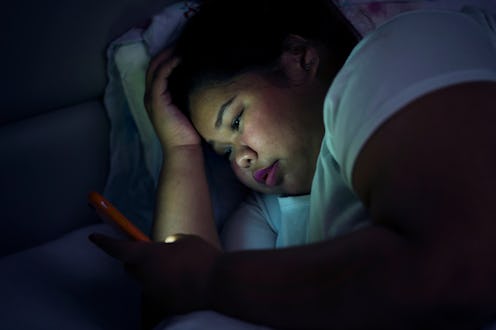
Apple’s Worldwide Developer Conference (WWDC) is always a delight, with users around the world wondering what the tech giant will announce next. This year, jaws dropped when Apple announced Sign In With Apple, a feature that promises the convenience of social media-authenticated logins with the privacy protection you’ve come to expect from Apple, and built-in cycle tracking in the Health app. But one highly anticipated update that was met with collective ooh’s and ahh’s was Dark Mode for iOS 13, the mobile adaptation of the beloved MacOS setting.
Dark Mode, as the name implies, sets your whole iPhone screen on a dark background, with lower contrast text. The setting is especially useful when you’re coding deep into the night, as Apple’s keynote lovingly alluded to in its opening video, but for those of you who simply scroll at night (hello, it me), you might just find that Dark Mode can help your sleep in unexpected ways.
“The eyes are generally more comfortable when the lighting is equal in intensity between the background and the object being watched,” American Optometric Association President Samuel D. Pierce, O.D., tells Bustle via email. “This is why a smart phone or laptop's brightness that seems very comfortable during the day seems uncomfortably bright at night. If the brightness is not matched, there is no irreparable harm to the eyes, but it does cause visual fatigue.” This visual fatigue, also known as eyestrain, is what’s behind your dry, achy eyes or even headaches at the end of the day. “Decreasing blue light exposure and limiting screen time and brightness can help people sleep better and feel more comfortable,” Pierce says.
You might already be putting this principal into practice if you use Night Shift, which puts an orange-yellow cast on your iPhone screen, mitigating the effects of blue light. (You can turn Night Shift on and off by 3D touching your brightness adjuster in the Control Center.) Blue light is known to mess with your circadian rhythm, aka the way your body regulates its sleep-wake cycle, in addition to causing eye strain. Though one small study of 12 teenagers found that Night Shift had less of an effect on sleep than anticipated, as CNET reported, medical professionals still generally operate under the principal that less blue light is better.
The benefit of Dark Mode is not just for low light situations, but in the beauty of the apps themselves. Apps that stack, like Mail, will appear with a gradient to demonstrate when a compose window, for example, is on top. Apps like Apple News will also use a gradient to delineate sections of the app while scrolling, in order to convey a sense of depth to the user. When it’s out, you’ll be able to use Dark Mode as the default mode for your iPhone, or schedule your screen to switch back and forth throughout the day (perhaps along with sunrise and sunset).
If you can’t wait to use Dark Mode until iOS 13 is released to the public later this fall, there are a number of things you can do to make your scrolling easier on the eyes. “Keeping the phone at a typical book-reading distance is more comfortable than holding the phone very close to the eyes, which lessens the focusing demand on the eyes,” Pierce says. Inverting colors or using grayscale, which you can find in your phone’s accessibility settings, will provide a similar high contrast, white on black display, although they won’t be as seamlessly designed as Dark Mode. Pierce also suggests enlarging the display font, which is another accessibility setting. The 20-20-20 rule — taking a 20-second break to view something 20 feet away every 20 minutes — can also help you avoid eye strain.